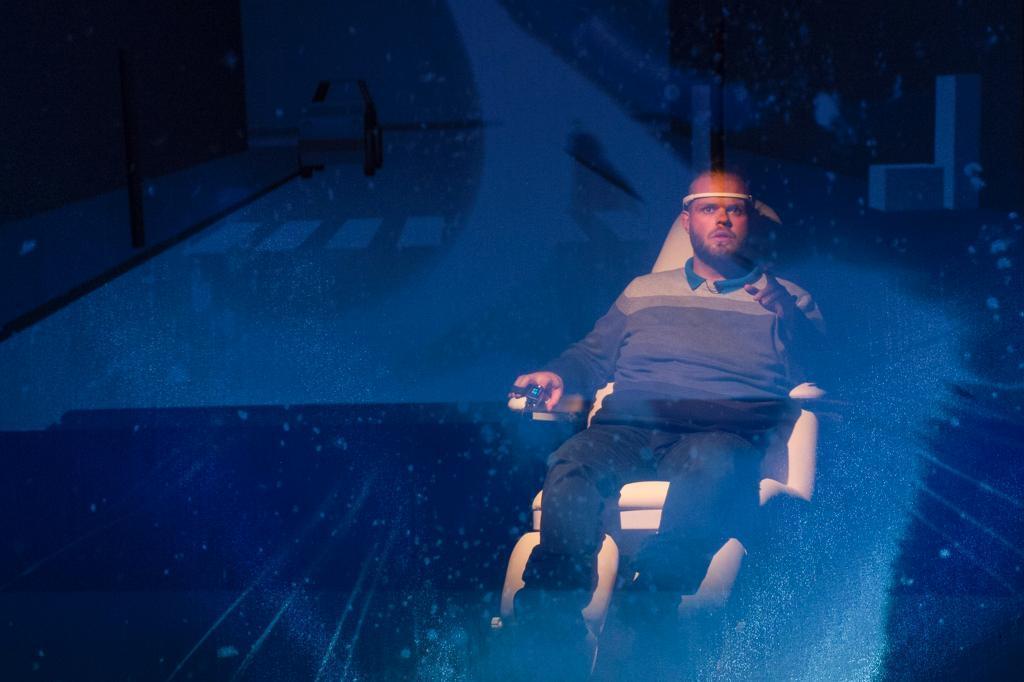

With the support of Brussels-Capital Region through the SHAPE funding program, IRISIB/LARAS and Demute are currently working on the development of an augmented reality headphone, a technology which will allow everyone to participate in immersive and interactive virtual audio experiences. Ultimately, the AHIA system will be modulable, and able to track up to 200 persons at the same time, in spaces up to 5000m²!
In brief, the headphone is tracked in real-time, both the position of the user and the orientation of its head, so as to create experiences that can be applied in any type of location. The AHIA system will enable creators to design ultra-realistic environments to enrich, augment and transform reality.
Thanks to the use of sensors and ultra-wideband (UWB) technology, the AHIA system is able to achieve high acurracy indoor 3D positioning for multiple devices in different location settings. The AHIA server receives data from the headphones and the sensors, mainly the position of the user/users and the orientation of their heads, and thanks to these data, AHIA can create immersive spatialised sound but also interactive experiences (trigger external devices). It will have its own experience creator software, and be OSC and ADM compatible.
The project is still in its early phase, with still a year to go before completion! Stay tuned! You can also visit Demute's website for more information.

With the support of the BOOST funding program managed by the Brussels-Capitale Region, the IRISIB/LARAS was involved in a project carried out by SonicVille360. The project aimed at developing an audio listening experience where the position and orientation of the listener were tracked in real time to offer sound spatialisation. The position and orientation data collected are indeed used to change the audio level, angle and reverberation of a sound object. Therefore, unlike conventional listening system, RSAA allows spatialisation of sound and what the user can hear will change according to his/her physical position and orientation.
You can see a presentation video here.

With the support of the BOOST funding program managed by the Brussels-Capitale Region, the IRISIB/LARAS took part in a project carried out by Cie Elapse together with TheTruthTechthe to develop an open socio-technologic innovation based on collaborative participation from the public and on research related to digital practices.
Cathexis offers the opportunity to experiment and participate in the development of a collaborative justice aiming at creating a fairer future, where truth and transparency are at the heart of the justice system.
More specifically, the IRISIB/LARAS has worked on sound management and on the collection, the processing and the visual rendering of biometric parameters (ex: body temperature, heart rate...)
The Trube has been showcased in Avignon, Brussels, Dijon, Belgrade, Sarajevo and Louvain-la-Neuve. You can see a presentation video here.

With the support of the FIRST funding program managed by the Walloon Region, the IRISIB/LARAS has developed a user-friendly and intuitive music creation app specifically designed with multi-touch devices in mind.
AMuSING addressed two main issues: 1) creating a geometric-based app adaptable to multi-touch interfaces and 2) developing a software not limited to only rhythm creation.
The app is a sequencer controlled by geometric shapes, which allows the user to create melodic loops and live music by manipulating simple polygons. All the melodic and rhythmic characteristics of the loops are represented by geometric properties of the shapes. These shapes produce chords when interacting with each other and modifying their size changes their corresponding tonal balance in an intuitive manner. A MIDI output makes it possible to use the app as a controller.
Due to its intuitive interface and the ability to import samples, the app can easily be used by beginners and experienced musicians alike! The app has been presented at the ICMC 2018 and you can read the findings here.

With the support of the EXPLORE funding program managed by the Brussels-Capitale Region, the IRISIB/LARAS has carried out in partnership with the Solvay Brussels Innovation Centre a research project aiming at developing a new type of gel electrolyte for lithium batteries.
The IRISIB/LARAS main tasks were to study the principles of Battery Management Systems (BMS),design efficiency and power-saving electronic circuits able to maintain battery safety. The final demonstrators are embedded electronics that demonstrate the possibilities of using the given batteries for IoT (Internet of Things).

Interactive kiosks are currently found in all major market segments: education, leisure, etc.
They offer users a number of services that are generally incomplete, static and not truly
interactive.
Since the popularization of equipment using multi-tactile technologies (iPhone, etc.), many
kiosk manufacturers have been investing in the development of products to use these
technologies. These companies also want to increase interactivity thanks to current
(Bluetooth, RFID...) and emerging technologies (Flight Time Camera,...)
Most products on the market today are restricted to applications selected by the
manufacturer and/or are sometimes very expensive. Developers of interactive kiosk
applications are therefore "blocked" by proprietary development tools - often limited -
linked to hardware.
Interactive kiosks are currently found in all major market segments: education, leisure, etc.
The objective of the project is to develop multimodal interactive terminals. They will, for
example, be able to recognize gestures, sounds, objects, people... and interact with their
environment.
The work will consist in developing a set of reusable software tools allowing rapid
prototyping and easy implementation of these different tools. The information provided by
the terminals will therefore be more dynamic and interactive since it will depend on the
factors surrounding the terminal: objects (train ticket whose bar code is scanned), presence
of people (via an RFID badge or camera), mobile devices (mobile phone via Bluetooth)...
The originality of the research consists in the development of simple tools that are
independent of current multi-tactile screen manufacturers in order to enable companies
that will use them to create ergonomic and ecological multi-touch interactive multi-mode
equipment.

SAMIFIS aims to develop an anti-spam application.
Spam is an endemic phenomenon on the Internet. It causes undesirable effects such as:
network overload, mail server congestion, virus propagation, phishing. From a simple user
point of view, spam is above all a daily nuisance.
Solutions already exist that allow spam filtering, separating spam from legitimate email. The methods used are numerous: from word by word analysis via regular expressions to dynamic
learning via artificial intelligence. The combination of several techniques to achieve more
satisfactory results than used individually. One of the added values of the project would
therefore be to offer modular and adaptable tools. Aspects of the research will include:

IMAGINE (study of the implementation of AlGorithms for image processing in an open hardware system) aims to accelerate image processing algorithms running on computers. To achieve this, the NVIDIA GPU computing architecture (CUDA) is used, providing a very high level of computing power. The project includes the creation of graphic software modules to create applications by assembling different image processing modules and thus generate high-performance code.